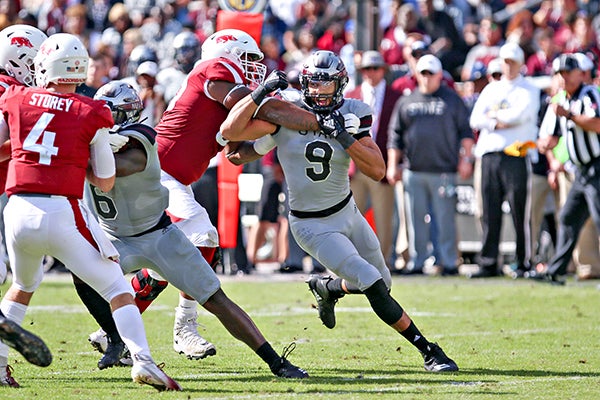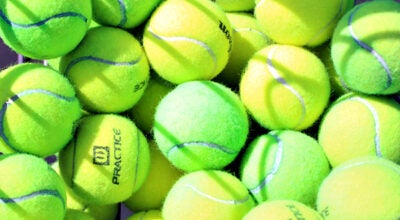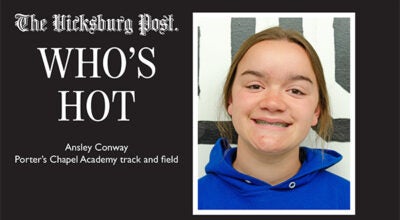Sweat, Metcalf turn heads at combine
Published 6:23 pm Monday, March 4, 2019

- Mississippi State defensive end Montez Sweat (9) ran a 4.41-second 40-yard dash at the NFL scouting combine last weekend. Sweat’s time was a record for defensive linemen. (Walter Frazier/For The Vicksburg Post)
INDIANAPOLIS (AP) — Scores of NFL prospects descended on Indianapolis over the weekend for the league’s annual scouting combine. Few made the kind of impression — or helped their draft stock — as Mississippi players Montez Sweat and D.K. Metcalf.
Sweat, a 6-foot-6, 260-pound defensive end from Mississippi State, clocked a 4.41-second 40-yard dash at Lucas Oil Stadium. It was the fastest time by a defensive lineman since at least 2003 and bested the mark of 4.43 seconds set by Emanuel Lawson in 2006.
Sweat’s time ranked 14th among all players. He was faster than all but two of 23 running backs who ran the 40 at the NFL scouting combine this week, and he was 0.12 seconds faster than Jadeveon Clowney’s time at the 2014 combine.
Sweat had 11 1/2 sacks and 14 tackles for loss last season after posting 10 1/2 sacks and 15 1/2 tackles for loss in 2017.
He said Saturday that he models his game after “old-time pass rushers like Jason Taylor,” and when asked what would set him apart among this year’s deep D-line class, Sweat said, “I think I would separate myself with my effort and my play. Just getting after the QB is what I do best.”
Metcalf, meanwhile, went viral over the weekend. The Ole Miss wide receiver ran the 40-yard dash in 4.33 seconds — tied for third-fastest among all of this year’s players — and had a vertical leap of 40.5 inches.
He also did 27 bench press reps of 225 pounds, tied with Arizona State’s N’Keal Harry for most among wide receivers, and measured an 83-inch wingspan.
Metcalf really turned heads on social media with a photo of himself and Ole Miss teammate A.J. Brown, shirtless, showing off their chiseled chests and six-pack abs.
Metcalf checked in at 6-foot-3 and 228 pounds with an incredibly low body fat index of just 1.9 percent. That’s about 10 percent lower than most wide receivers.
Metcalf said he got his impressive physique by working out in preparation for the combine and changing his diet.
“At Ole Miss, we ate however we wanted to,” the Oxford native told USA Today. “At EXOS they really cut down on bad foods for you, like high sugar, high carbs, and they really honed in on proteins and vegetables and all of that.”
Metcalf says he was surprised the photo got so much attention and he hears about it everywhere he goes, from fans wondering what his diet and workouts are like to coaches talking about his physique.
“Every team room I walk into,” Metcalf said, “they’re always like, ‘Wow. You are really that big.’”
Metcalf’s draft stock rose thanks to both his photos and combine performance. He left Ole Miss after suffering a neck injuries halfway through his sophomore season in 2018. He caught 65 passes for 1,215 yards and 14 touchdowns in a season and a half with the Rebels, and ranked third in the Southeastern Conference in receiving yards before his injury last season, but was still a likely mid-round pick.
Now, teams have taken notice and he is considered a likely high first-round pick by some draft experts.
“We knew Metcalf was a special athlete. I thought he’d perform well here in Indianapolis. I didn’t know he could run a 4.33 40, though. That’s in the territory of Julio Jones and Calvin (Johnson),” ESPN draft expert Mel Kiper Jr. wrote on Twitter. “Now, his medical report from teams is going to be important — remember that he underwent neck surgery in October — so I want to hear from more people in the league. But Metcalf is in the top-10 discussion, and that’s where I had him in my most recent mock draft.”
Metcalf has already met with the Browns, Raiders, 49ers, Redskins and Seahawks.
The Raiders have three first-round picks, and head coach Jon Gruden gushed about Metcalf at the combine.
“He looked like Jim Brown. I mean he’s the biggest wideout I’ve ever seen, and you got to ask yourself, ‘Who’s tackling this guy?’” Gruden told USA Today. “So, if you’re a 179-pound corner, and you’re tackling a 235-pound back, or a 235-pound wideout or a tight end you’ve got to ask yourself, ‘Is this what I want to do?’”





